Blood Vessel (FSI) with the Pulse Velocity, CFD Simulation Ansys Fluent Training
$210.00 $105.00 Student Discount
In this project, a Blood Vessel (FSI) with Pulse Velocity has been simulated and the results of this simulation have been investigated.
Click on Add To Cart and obtain the Geometry file, Mesh file, and a Comprehensive ANSYS Fluent Training Video.To Order Your Project or benefit from a CFD consultation, contact our experts via email (info@mr-cfd.com), online support tab, or WhatsApp at +44 7443 197273.
There are some Free Products to check our service quality.
If you want the training video in another language instead of English, ask it via info@mr-cfd.com after you buy the product.
Description
Blood Vessel Project Description
In this project, which has been done by Ansys Fluent software, a blood vessel is simulated with a wall, where the displacement of the wall is also visible. We have defined the pulse velocity using UDF for the input, and the output is atmospheric pressure. This FSI simulation was performed inside the fluent.
Geometry & Mesh
The three-dimensional geometry of this project has been produced with Spaceclaim software The length of the calculation domain is 72 mm, and its height and width are 5 mm.
The meshing of this project has been done with Ansys Meshing software, and the type of elements is unstructured. Also, the total number of elements is 55632.
Blood Vessel CFD Simulation
- the pressure-based solver method has been selected.
- The simulation is transient.
- The gravity effect is ignored.
The following tables represent a summary of the defining steps of the problem in this project and its solution:
| Models | ||
| Viscous model | k-w | |
| Model | SST | |
| material | ||
| blood | Density | 1060 kg/m^3 |
| Viscosity | 0.004 kg/(m-s) | |
| vessel | Density | 1500 kg/m^3 |
| Youngs modulus | 1.5e06 pa | |
| Poisson ratio | 0.32 | |
| Boundary conditions | ||
| Inlet | Velocity inlet | |
| Velocity magnitude | UDF | |
| Outlet | Pressure outlet | |
| Gauge pressure | 0 pa | |
| Walls | Intrinsic FSI | |
| Solution Methods | ||
| Pressure-velocity coupling | Coupled | |
| Spatial discretization | Pressure | Second-order |
| Momentum | second-order upwind | |
| Turbulent kinetic energy | first-order upwind | |
| Turbulent dissipation rate | first-order upwind | |
| Initialization | ||
| Initialization method | Standard |
Results
After the simulation, we can observe the velocity and pressure contours inside the vessel, and we can also examine the stresses and displacements created in the vessel wall due to the force exerted by the blood.
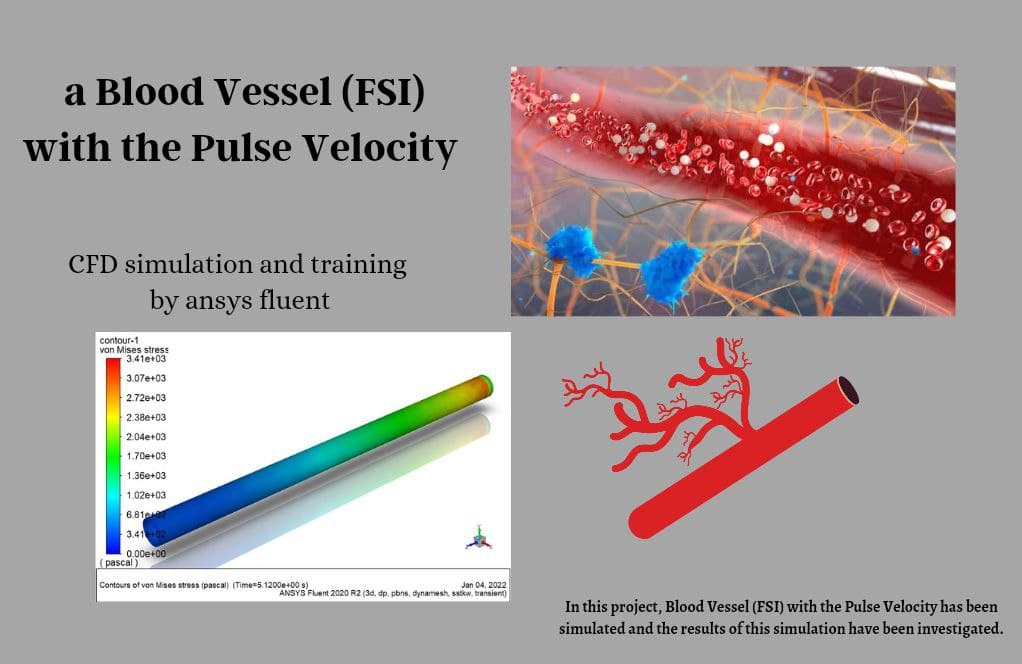
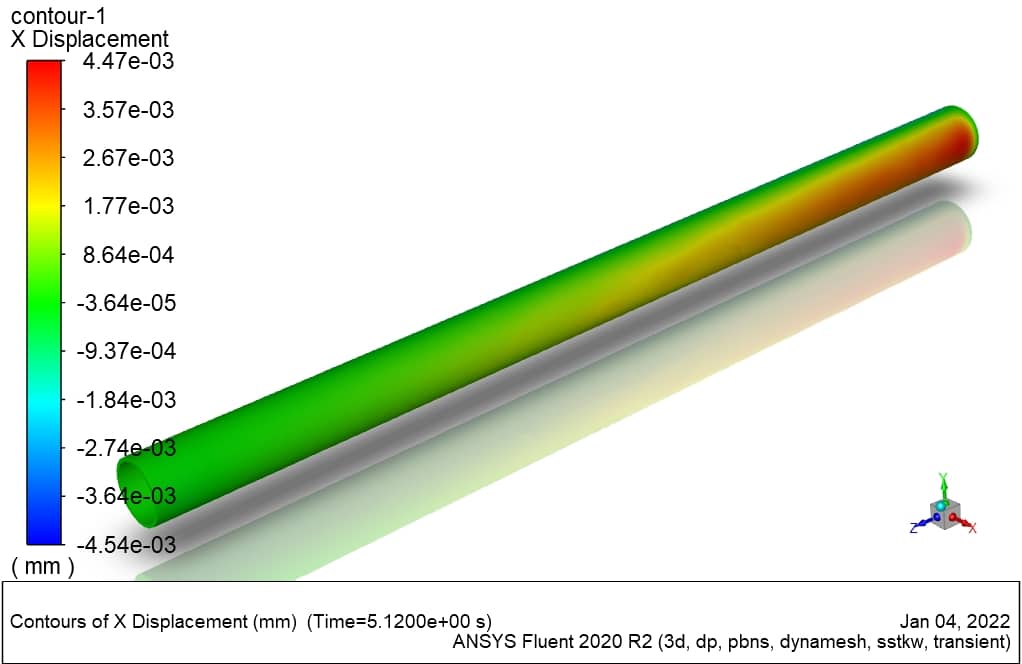
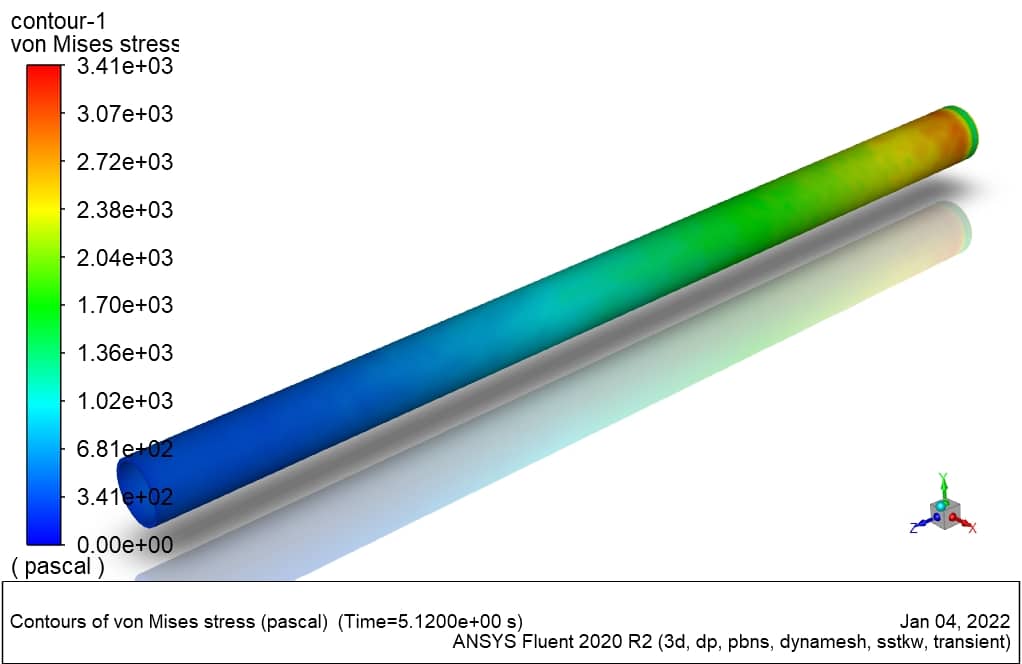
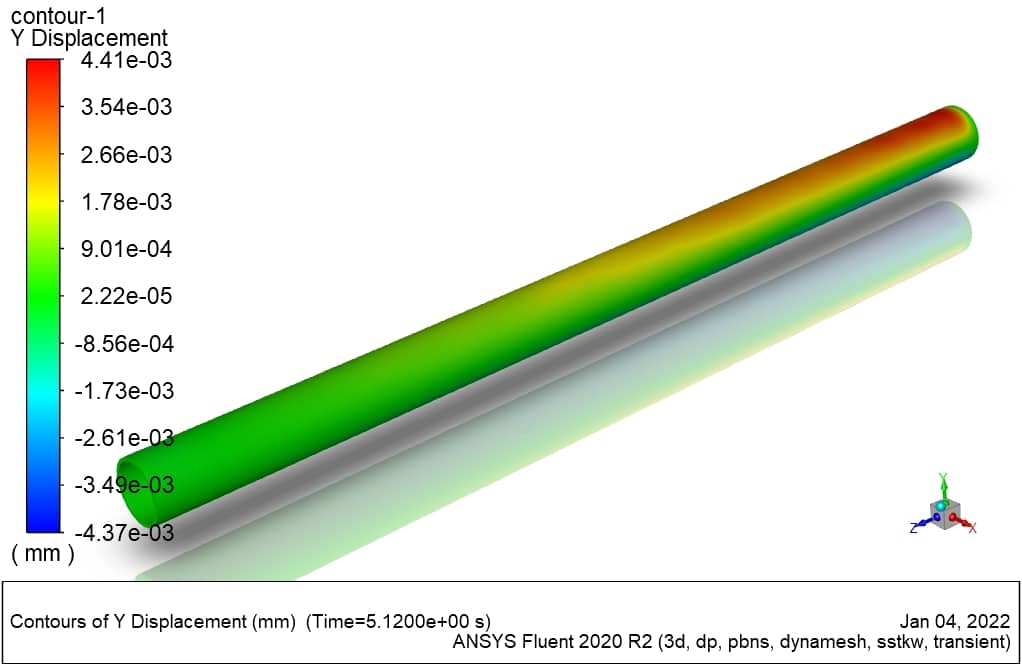
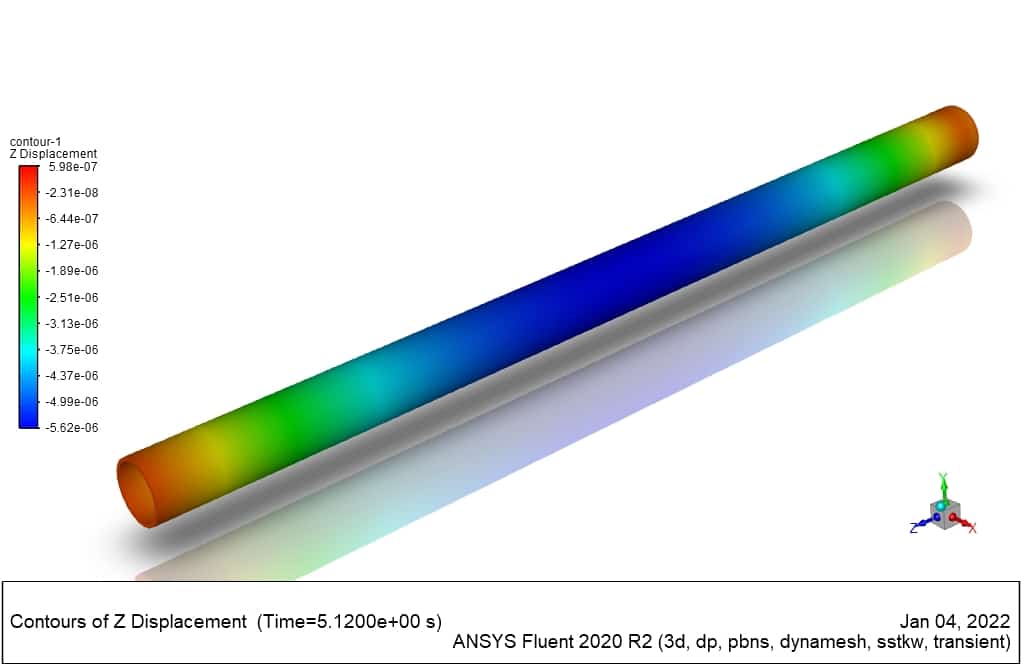
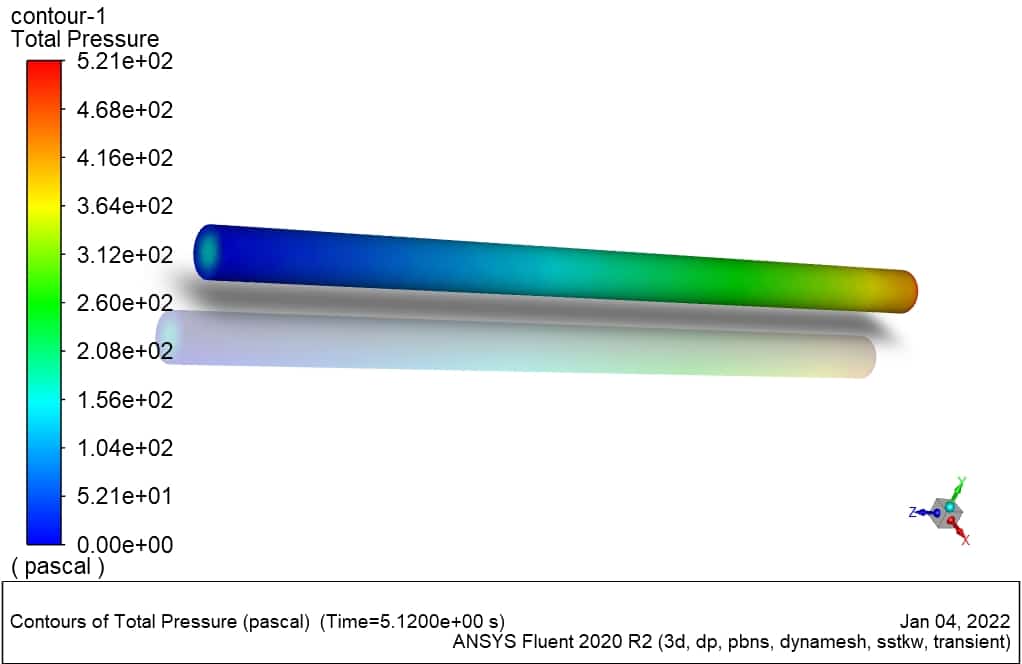




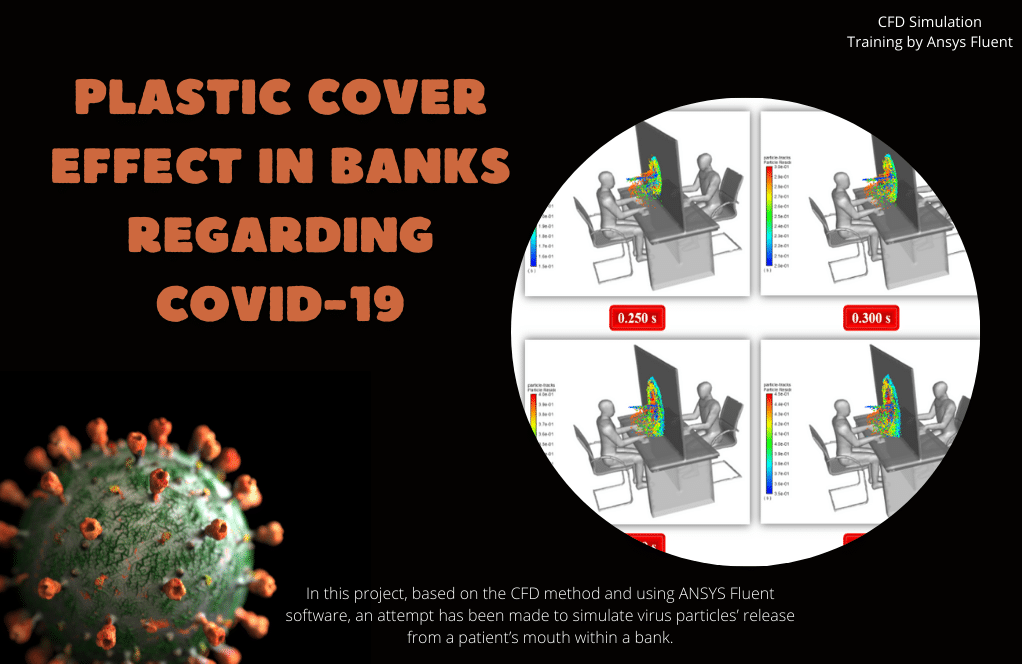

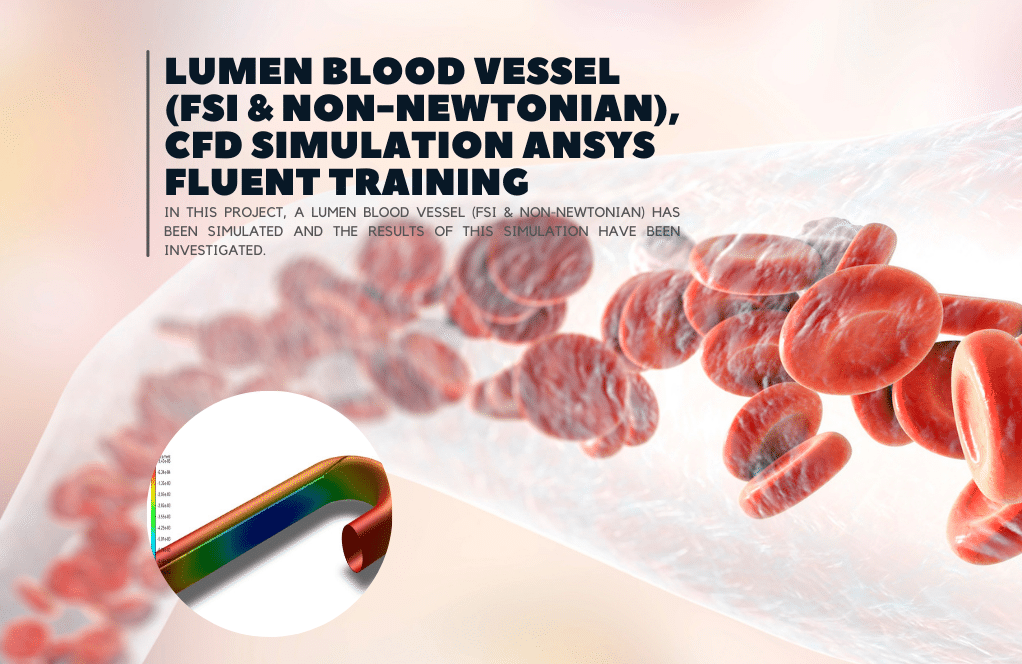

Ophelia Mills –
The results section mentions ‘after the simulation’. Can you tell more about what kind of post-processing can be performed to analyze the vessel stresses and displacements in more detail?
MR CFD Support –
For detailed analysis of the vessel stresses and displacements, post-processing tools in ANSYS can be used. This typically involves examining the equivalent (Von Mises) stress and total deformation in the vessel walls. Specifically, users can create stress contour plots to visualize stress distribution and displacement vectors or contour plots for observing the movement of the vessel walls over each time step.
Ms. Nella Osinski –
I was impressed! The Blood Vessel FSI simulation captured pulsating blood flow so vividly. I appreciate the details—I felt like I was looking inside an actual, working blood vessel. A hearty thanks to the MR CFD team for such enriching, accurate visual learning tools.
MR CFD Support –
Thank you so much for your kind words and positive feedback on our Blood Vessel FSI simulation learning product. We are delighted to know that the simulation’s vividness impressed you. Our team at MR CFD is committed to providing high-quality simulations that enhance visual understanding. It thrills us that our product has enriched your learning experience. We are always here if you have any more questions or need further assistance!
Toni Brekke –
Phenomenal results! The way stress and displacement are accounted for in the vessel wall provides deep insights. Can we visualize the dynamic displacement of the vessel wall over the cardiac cycle?
MR CFD Support –
Absolutely, the FSI simulation captures the dynamic interaction between the blood flow and the vessel wall, including wall displacement linked to the pulsatile nature of blood flow. By reviewing the output data, particularly the transient structural results, it is possible to create animations that visualize the displacement of the vessel wall over the cardiac cycle. This visualization helps in understanding the biomechanical behavior of the blood vessel under pulsating conditions.
Elvis Gutkowski –
This product and its CFD simulation helped me grasp the dynamics of blood flow and the interaction with vessel walls! The detail within the geometry and mesh really brought the project to life.
MR CFD Support –
Thank you for your feedback! We are delighted to hear that our Blood Vessel FSI CFD Simulation course has enriched your understanding of cardiovascular flow dynamics. Your acknowledgment of the detailed geometry and meshing is much appreciated. If you have more questions or need further assistance in future learning endeavors, feel free to reach out to us!
Hank D’Amore –
I learned so much from the ‘Blood Vessel (FSI) with the Pulse Velocity’ CFD simulation training. The real-time interaction between blood flow and vessel wall was fascinating. Could you share how the UDF for pulse velocity was applied and executed within the simulation parameters?
MR CFD Support –
Great to hear that you’ve gained valuable insights from our Blood Vessel simulation training. The UDF (User-Defined Function) for pulse velocity was programmed to replicate the pulsatile nature of blood flow within the vessels. This UDF was then read and compiled in ANSYS Fluent, and applied as boundary conditions at the inlet of the vessel to ensure the accuracy of physiological conditions simulated. Executed over the defined time intervals, the UDF dynamically updates the velocity profile in accordance with the specified pulse velocity data.
Kristy Welch –
The tutorial on FSI simulation for a blood vessel’s pulsatile flow was eye-opening. The visuals of wall displacement alongside blood flow dynamics provided a clear insight into the real-world physiology!
MR CFD Support –
Thank you for your positive feedback! It’s fantastic to hear that our tutorial on blood vessel FSI simulation has provided you with clear insights and a better understanding of real-world physiological conditions. Your satisfaction is our top priority, and we appreciate you taking the time to compliment our product.
Mrs. Rosalinda Koelpin I –
This product review is just a complement: I found the detailed description of the material properties for both the blood and vessel in the CFD Simulation very effective for my understanding of cardiovascular biomechanics.
MR CFD Support –
Thank you for your positive feedback! We are thrilled to hear that our simulation has enhanced your understanding of cardiovascular biomechanics. Your satisfaction is our top priority, and we appreciate you taking the time to share your experience.
Ocie Kautzer II –
Is it possible to observe the dynamic deformation of the blood vessel wall in the results, and how does the applied UDF for the pulse velocity affect this deformation?
MR CFD Support –
Yes, the dynamic deformation of the blood vessel wall can be observed in the results from the FSI simulation. The applied UDF for the pulse velocity defines a time-dependent boundary condition that replicates the pulsatile nature of blood flow. This varying inflow creates fluctuations in pressure and shear forces on the vessel walls, leading to their dynamic deformation throughout the cardiac cycle.
Isai Hudson –
I was really intrigued by the FSI simulation of the blood vessel with pulse velocity. It seems like a complex procedure. The review didn’t mention what specific results were observed regarding the stresses and displacement induced in the vessel wall. I’m curious how these factors could potentially influence the overall findings of this project. Could you provide more information on these results and their implications?
MR CFD Support –
The simulation is designed to meticulously capture the interplay between the blood flow and the vessel wall experienced in real-life physiological conditions. As a result of the simulation, stresses and displacements within the vessel wall were thoroughly analyzed to mimic the pulsatile nature of blood circulation. These data contribute significantly to understanding vascular diseases and the mechanical properties of blood vessels under varying blood pressure conditions. This understanding is critical for designing implants, medical devices, and informing surgical procedures. We’re pleased to hear your interest in the intricate details of this FSI simulation and we hope that our solution provides valuable insights for medical and biomechanical research.
Kathryn Halvorson –
This training material is comprehensive and seems spot on for learning about blood vessel FSI simulations! The detail in defining the pulse velocity using UDF for input, and carefully explaining each step of the simulation process is extremely useful to understand complex interactions in cardiovascular studies. Great work!
MR CFD Support –
Thank you for your positive feedback! We’re thrilled to hear that the tutorial provided the comprehensive understanding you needed for the FSI simulation of blood vessels. It’s our goal to deliver detailed and useful learning materials for complex studies like this one. We appreciate your comment and if you have any more questions or require further assistance, feel free to reach out!
Ayla Larkin DDS –
The attention to detail in the Blood Vessel (FSI) with Pulse Velocity simulation is impressive. The use of a UDF for the input pulse and the visualization of the wall displacement provides an insightful illustration of the dynamics at play within blood vessels. The meticulous setup from geometry to mesh, and carefully chosen boundary and material properties showcases a well-thought-out approach to replicating physiological conditions. This must have provided a rich understanding of the interaction between blood flow and vessel wall elasticity.
MR CFD Support –
Thank you for your positive review! We are glad that you appreciate the level of detail and thought that went into the Blood Vessel FSI simulation with Pulse Velocity. At MR CFD, we strive to provide comprehensive and realistic simulations that offer deep insights into complex fluid-structure interactions such as those in the human vascular system. Your feedback is very encouraging for our team!
Javonte Frami –
After finishing the ‘Blood Vessel (FSI) with the Pulse Velocity, CFD Simulation Ansys Fluent Training,’ I feel really accomplished! The complexity of simulating pulsatile flow and its interaction with vessel walls beautifully captured the multi-physic nature of the problem. Seeing the stresses and displacements within the vessel walls was particularly enlightening. Can’t wait to apply these techniques to my work in biomedical device design!
MR CFD Support –
Thank you for your positive feedback! We are thrilled to hear that the training has equipped you with valuable skills for your projects in biomedical device design. It’s fantastic to know that the simulation provided practical insights into the dynamics of pulsatile flow and its effects on vessel walls. If you have any further questions or plan to delve deeper into other applications, don’t hesitate to reach out.
Abigale Pacocha –
I am fascinated by this project! What kind of outcomes can be expected regarding the stress distribution in the vessel wall due to the pulsatile blood flow?
MR CFD Support –
Thank you for your interest in our Blood Vessel FSI simulation training. The expected outcomes for stress distribution in the vessel wall include detailed visualizations of stress and strain patterns. These outcomes help interpret the mechanical response of the vessel wall to pulsating blood pressures, such as identifying high-stress regions that may indicate potential sites for vascular disease or injury. Dynamic simulations of this kind offer insights into the biomechanical integrity of the vessel over the cardiac cycle.
Collin Borer –
I found the details on the simulation setup to be really clear and informative. Are the resulting blood flow patterns and vessel wall stresses produced in this CFD simulation comparable to what is observed in actual physiological conditions?
MR CFD Support –
Thank you for your positive feedback! Yes, the blood flow patterns and vessel wall stresses from the simulation are designed to be as close to physiological conditions as possible. The mathematical models used are based on real physical properties of blood and vessel tissues, ensuring that the outcomes mirror real-life scenarios under similar conditions.
Mrs. Maudie Adams V –
I’m fascinated by the dynamic aspect of the blood vessel simulation. Could you explain how the wall displacement due to the pulse velocity is captured in this model?
MR CFD Support –
The wall displacement resulting from pulse velocity in the blood vessel is captured using the Fluid-Solid Interaction (FSI) simulation. In the Ansys Fluent environment, a User-Defined Function (UDF) is written and used to simulate the pulsatile blood flow entering the vessel. The FSI is set up to allow the vessel wall to respond to the pressure and shear stresses exerted by the blood flow. The solver computes the interaction between the blood and vessel wall, leading to wall deformations over time that are synchronized with the pulse velocity.
Hillary Schneider –
I am incredibly impressed with how detailed the Blood Vessel FSI CFD simulation is. The inclusion of relevant boundary conditions and UDF for pulse velocity demonstrates a deep understanding of biological fluid dynamics.
MR CFD Support –
We thank you very much for your kind words! It’s great to hear that you appreciate the level of detail and complexity in the Blood Vessel FSI CFD simulation. Our goal at MR CFD is to ensure that our simulations are as accurate and informative as possible. If you have any more feedback or need further assistance, please don’t hesitate to reach out to us.
Dawn Stanton –
I’m impressed with the details provided on the FSI simulation of blood vessel dynamics. Are deformations of the vessel wall during the pulse modeled accurately, and do these deformations affect the flow of blood significantly?
MR CFD Support –
In the simulation, deformations of the blood vessel wall are modeled accurately by considering the proper material properties and boundary conditions reflecting realistic physiological scenarios. The two-way FSI approach allows the deformation of the vessel wall driven by the pulsatile nature of blood flow to affect the fluid dynamics within the vessel. This interaction between structure and fluid can significantly influence the blood flow behavior, which is why FSI models are essential to capture the dynamic nature of cardiovascular biomechanics more realistically.
Prof. Haleigh Schumm –
The training material for Blood Vessel (FSI) simulation sounds comprehensive. The explanation of wall displacement and accounting for pulse velocity using UDF a great detail which must enrich the learning experience. Does the content of the training cover step-by-step instructions for generating UDFs in ANSYS Fluent?
MR CFD Support –
Yes, the content of the training includes step-by-step instructions for creating User-Defined Functions (UDFs) in ANSYS Fluent, which are critical for setting up specific boundary conditions like pulse velocity in blood vessel simulations. UDFs offer great flexibility to model complex behaviors such as pulsatile flow and interact with the FSI analysis environment effectively.
Ms. Alexa DuBuque –
I’ve watched the results of the simulation, and the vessel deformation was so well-presented. How did you ensure the accuracy of the UDF for the pulse velocity?
MR CFD Support –
Thank you for your compliment! To ensure the accuracy of the UDF (User Defined Function) for the pulse velocity, we first relied on benchmark pulse profiles derived from physiological data. The UDF was then rigorously tested to ensure that the profile of pulse velocity over time matched the expected characteristic of a blood pulse in a vessel. Additionally, iteratively testing and refining our simulation process helped to hone in on an accurate representation.
Dr. May Schumm –
I appreciate the level of detail in simulating the blood vessel dynamics with pulse velocity. The inclusion of a wall displacement is quite remarkable. It’s clear that careful consideration was taken in setting up both the boundary conditions and the material properties to mimic biological systems closely. Well done on creating such an intricate simulation that provides valuable insights into cardiovascular fluid dynamics.
MR CFD Support –
Thank you for your kind words! We’re thrilled to hear that you found the simulation of the blood vessel with pulse velocity using the Fluid Solid Interaction method detailed and insightful. Our goal is always to provide accurate and valuable simulations that reflect real-world scenarios, especially in complex biological systems. Your feedback is greatly appreciated, and it inspires us to continue delivering high-quality simulation training.
Sanford Sawayn –
The Blood Vessel (FSI) simulation is absolutely fascinating. It showcases an intricate numerical study of pulse-driven blood movement and vessel wall interaction, providing valuable insights into hemodynamics. Analyzing the vessel’s stresses and displacements, influenced by blood force, is critical for understanding cardiovascular phenomena. Moreover, using UDF for pulse input is a touch of realism that enhances the simulation’s credibility. Well done, team!
MR CFD Support –
Thank you for your glowing review! We’re glad you found the simulation study insightful and that you appreciated the realism added through the usage of UDF for pulse velocity input. We strive to create simulations that not only represent complex physical phenomena accurately but are also useful for professionals in the field. Your feedback is invaluable to us!
Dr. Armando Marquardt I –
I am thoroughly impressed with the level of detail in the blood vessel FSI simulation. The use of UDF to define pulse velocity and a transient solver for capturing the dynamic behavior of the blood flow is remarkable. It is also noteworthy how the model has been simplified with defined gravity effects considering the scale. The utilization of SST in the blood’s viscosity model and the attention to the wall’s displacement due to pulse pressure changes showcases the project’s complexity. Well done MR CFD on an educational and advanced training resource!
MR CFD Support –
Thank you for sharing your positive feedback regarding our Blood Vessel (FSI) simulation training product! We are overjoyed to hear how impressed you are with the details and the techniques used, such as the UDF for pulse velocity and the transient analysis. Your recognition of the efforts to simplify the gravity effects and the emphasis on wall displacement also highlights the depth of our simulation’s realism. Thank you for choosing our training for your educational needs – it’s wonderful customers like you that incentivize us to keep providing top-notch CFD learning experiences!
Francisco Cole –
The simulation visuals helped me to fully understand the pulsatile behavior of blood flow and its impact on the vessel wall. It’s fascinating how realistic the results are!
MR CFD Support –
Thank you for your appreciation! We’re glad that the simulation results provided a clear and realistic view of the hemodynamics you’re interested in. If you need to further your understanding or explore other variables, don’t hesitate to contact us.
Morton Kuphal –
The blood vessel simulation was truly insightful. Seeing the pulse-induced displacements on the vessel wall was fascinating and the details provided about the UDF for pulse velocity and the chosen material properties were highly beneficial in understanding the physiological conditions that were simulated. Bravo for such an in-depth and applicable analysis.
MR CFD Support –
Thank you so much for your kind words! We are delighted to hear that you found the blood vessel simulation insightful and of great help in understanding the complexities of physiological blood flow. Knowing that our users can appreciate the depth and practicality of our simulations motivates us to continue providing high-quality CFD analyses. If you have any farther questions or another project in mind you’d like us to explore, please let us know!